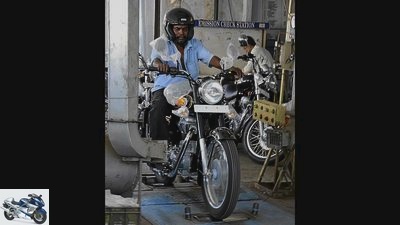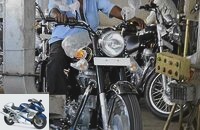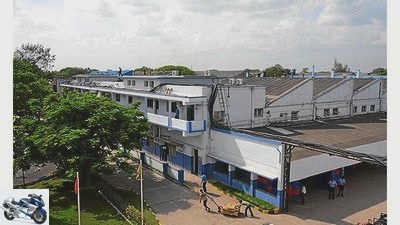Table of contents

Horenburg
motorcycles
Report: Royal Enfield factory visit
Report: Royal Enfield factory visit
A visit to the English cult brand
Royal Enfield unveiled the first motorcycle in Great Britain in 1901. The Bullet has been rolling off the assembly line in India for 56 years, where Royal Enfield is now a cult. Just like the films from the dream factory Bollywood. How does it work?
Berit Horenburg
October 27, 2011
Prottl, prottl, prottl. The single-cylinder 500 of the Royal Enfield Classic thuds. “My friends envy me.” Indian journalist Varoon P. Anand drives a new Royal Enfield Classic Chrome for a walk in the desert. Just as a trial. What makes him completely excited: “Royal Enfield is a myth.”
The legend is just coming back to life. Because the smallest Indian motorcycle brand was languishing for years. For a variety of reasons. The nickname for the old Enfields with separate engine and transmission was “Royal Oilfield”. An allusion to the constant oil loss of the originally British single, which has been manufactured as a bullet with a right-hand gearshift almost unchanged since the 1930s. The tradition, in the wake of which Royal Enfield stylized itself as the world’s oldest producing motorcycle brand, was opposed to quality and handling problems. What remained was a loyal fan base who delighted in flywheel mass and torque, but hardly ensured the company’s survival.
Much has changed. The engine and gearbox now form a unit in one housing, whereby the engine complies with European emission standards. Two spark plugs are a much-advertised must-have in India. The circuit has been on the left since 2005, and there is an electric starter next to the kick. In the 500 version, the gasoline is even injected electronically. The Classic was presented in India in November 2009.
Buy complete article

Report: Royal Enfield factory visit
A visit to the English cult brand
6 pages) as PDF
€ 2.00
Buy now
A direct hit: “It now accounts for around 40 percent of our sales,” says Venki Padmanabhan, Managing Director of Royal Enfield since January 2011. A total of 90 percent of all Enfields sold in India are the cheaper 350s with carburettors and 20 hp. Customers wait eight months for the Classic 350 because production is lagging behind.
In the old plant in Thiruvottiyur near Chennai, only 200 people are involved in sales, design and development. Around 1500 employees manufacture motorcycles. Six days a week, around the clock, in three shifts. The halls are swept clean, the unionized workers have set breaks and eat in the works canteen. Instead of robots and machines, manual labor predominates. After assembly, the motors are placed in subframes. Test runs follow before workers install them as load-bearing elements in the black painted frames. Sheet metal parts such as the fenders and tank are chrome-plated or painted by hand. Jaya and his brother Kishore Kumar draw the lines on the tanks with brushes – without lifting them off. Around 70 percent of the parts, from the frame to the wheels to the spring elements, come from Indian suppliers. Only the electronic injections come from Keihin in Japan and the batteries from Italy. 350cc and 500cc bikes are produced on two assembly lines, which roll onto a test stand after final assembly. A pilot then drives down a test track, checking the engine and chassis again.
Instead of 52,574 motorcycles as in the previous year, Enfield produced over 70,000 in 2011. This means that the capacity at the outdated plant is exhausted. In September 2011 the company bought land. The new plant near Chennai, where production is scheduled to start in the spring of 2013, is designed for 150,000 motorcycles per year and, at over 200,000 square meters, five times the size of the old one. “We have Daimler and Nissan as neighbors,” enthuses Enfield sales manager Shaji Koshy. First, the paint shop and final assembly move to the new halls, the engines will continue to be built in Thiruvottiyur. A museum is linked to the new, modern work.
Because the marketing of Royal Enfield works: beauties in Bollywood films, which millions of Indians watch, prefer to loll on the seats of Royal Enfields, the advertising campaigns are aimed specifically at young men. For example with the appeal “Leave Home”, in German: Leave your parents’ home. Supported by the announcement: “Only three percent of women have friends who still live at home. 88 percent have some who live alone. ”In a country where parents still arrange marriages, it smells like adventure. Whoever rides a Royal Enfield is different from thousands of Honda and Bajaj pilots. Unlike the others, more and more people want to be in India.

Horenburg
The old factory in Chennai: Around 70,000 Royal Enfields are produced there every year. In 2012 the company is rebuilding.
That includes vacation. “Indians with office jobs work up to 16 hours a day,” says Padmanabhan. Royal Enfield sells itself as a recreational pleasure. A new invention in India, where the patriarch often transports the whole family on a bike.
“We offer trips. In addition, there are 200 Enfield owner clubs in India that have 20 to 700 members, ”says Koshy. The big tours with illustrious names such as “Himalayan Odyssey” or “Rann of Kutch”, which accompany mechanics and doctors, are published in short versions via video on the Internet. Once a year the fans celebrate a huge party in Goa. “This is how we sell motorcycles,” says Padmanabhan. “Keep riding.” Because myth or not, the single-cylinder bikes weighing over 185 kilograms are considered heavy macho parts in India, where 100 cc mopeds weighing 100 kilograms are common.
A new version of the Classic 500, which Enfield presented in September 2011, costs the equivalent of 2200 euros in new Dheli as Classic Chrome. Changes: new mapping of the injection system, 19-inch instead of 18-inch wheel at the front. The modified axle mount on the fork ensures more caster. The hope of getting a grip on all problems such as unstable straight-line stability at higher speeds was not fulfilled. Which doesn’t matter on the miserable Indian streets, where cows frolic and anarchy reigns. “We’re working on quality and handling,” says Padmanabhan.
To ensure that Royal Enfield continues to enjoy success, new motorcycles are planned. The company has already announced a cafe racer with a new frame for 2012. There are also rumors about planned 700 cc bikes and a diesel version. According to Padmanabhan, one thing is certain: “We want to preserve the DNA. The beat has to stay. “
Related articles
-
Royal Enfield Classic 500 EFI put to the test
www.bilski-fotografie.de 16 pictures www.bilski-fotografie.de 1/16 Royal Enfield Classic 500 EFI put to the test. www.bilski-fotografie.de 2/16 If it…
-
On the way along the Ahr with the Enfield Royal Classic
Deleker 23 pictures Deleker 1/23 On the way through the Eifel with the Enfield Classic 500 EFI. Werel 2/23 A day in the Eifel with a driven distance of…
-
Report: Visit to the Magura factory
Jahn motorcycles Report: Visit to the Magura factory Report: Visit to the Magura factory Specialist in grips, brakes and handlebars At Magura, the relics…
-
Driving report Royal Enfield Meteor 350
News 2022 New motorcycle items for 2022 Tyson Jopson 14th pictures Tyson Jopson 1/14 To celebrate the milestone anniversary, the oldest motorcycle…
-
Royal Enfield will also build electric motorcycles from 2024
Photo: jkuenstle.de 30th pictures Royal Enfield 1/30 At EICMA 2017, Royal Enfield presented the two new models Interceptor INT 650 and Continental GT…
-
Report to the Alpinestars factory visit
Alpinestars 15th pictures plant 1/15 This is what they used to look like: motocross boots. The following pictures show you the Alpinestars story and how…
-
Report on Royal Enfield – visit to Oragadam plant
Markus Biebricher counselor traffic & business Report on Royal Enfield – visit to Oragadam plant Report on Royal Enfield – visit to Oragadam plant More…
-
Royal Enfield in the 2020 model year
Royal Enfield. 26 pictures Royal Enfield. 1/26 Royal Enfield Bullet 500 (Marsh Gray). Price: from 4,819 euros. Royal Enfield. 2/26 Royal Enfield Bullet…
-
Report Factory visit Bridgestone
Plom 13th pictures 1/13 50 test motorcycles are available on the test site at the Nasu tire plant. 2/13 Long nose Lohse in the land of smiles: a radiant…
-
Royal Enfield Bullet conversion from Neev Motorcycles
Neev Motorcycles 6th pictures Neev Motorcycles 1/6 Neev Motorcycles converts a Royal Enfeild Buellt 500 into a steam punk chopper. Neev Motorcycles 2/6…